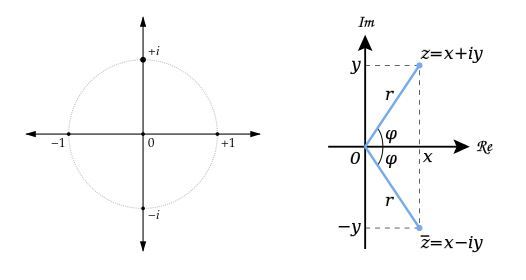#rationalism
Beyond the Enlightenment Rationalists:
From imaginary to probable numbers - IV

(continued from here)
One of the notable things the Rationalists failed to take into account in their analysis and codification of square roots was the significance of context. In so doing they assured that all related concepts they developed would eventually degenerate into a series of errors of conflation. Do not ever underestimate the importance of context.
Mathematicians, for example, can show that for any 3-dimensional cube there exists a 2-dimensional square, the area of which equals the volume of the cube.[1] And although that is true, something has been lost in translation. This is another of the sleights of hand mathematicians are so fond of. Physicists cannot afford to participate in such parlor tricks as these, however mathematically true they might be.[2]
We will begin now, then, to examine how the mandalic coordinate approach stacks up against that of imaginary numbers and quaternions. The former are holistic and respective of the natural order; the latter are irresponsibly rational, simplistic and, in final analysis, wrong about how nature works.[3] Ambitious endeavor indeed, but let’s give it a go.
We’ve already looked at how the standard geometric interpretation of imaginary numbers in context of the complex plane is based on rotations through continuous Euclidean space. You can brush up on that aspect of the story here if necessary. The mandalic approach to mapping of space is more complicated and far more interesting. It involves multidimensional placement of elements in a discrete space, which is to say a discontinuous space, but one fully commensurate with both Euclidean and Cartesian 3-dimensional space. The holo-interactive manner in which these elements relate to one another leads to a probabilistic mathematical design which preserves commutative multiplication, unlike quaternions which forsake it.
Transformations between these elements are based on inversion (reflection through a point) rather than rotation which cannot in any case reasonably apply to discrete spaces. The spaces that quantum mechanics inhabits are decidedly discrete. They cannot be accurately detailed using imaginary and complex numbers or quaternions. To discern the various, myriad transitions which can occur among mandalic coordinates requires some patience. I think it cannot be accomplished overnight but at least in the post next up we can make a start.[4]
(continuedhere)
Image: A drawing of the first four dimensions. On the left is zero dimensions (a point) and on the right is four dimensions (A tesseract). There is an axis and labels on the right and which level of dimensions it is on the bottom. The arrows alongside the shapes indicate the direction of extrusion. By NerdBoy1392 (Own work) [CC BY-SA 3.0orGFDL],via Wikimedia Commons
Notes
[1] If only in terms of scalar magnitude. Lost in translation are all the details relating to vectors and dimensions in the original. Conflation does not itself in every case involve what might be termed ‘error’ but because it always involves loss or distortion of information, it is nearly always guaranteed to eventuate in error somewhere down the line of argument. The point of all this in our context here is that, in the history of mathematics, something of this sort occurred when the Rationalists of the Enlightenment invented imaginary and complex numbers and again when quaternions were invented in 1843. These involved a disruption of vectors and dimensions as treated by nature. The loss of information involved goes a long way in explaining why no one has been able to explain whyandhow quantum mechanics works in a century or more. These misconstrued theses of mathematics behave like a demon or ghost in the machine that misdirects, albeit unintentionally, all related thought processes. What we end up with is a plethora of confusion. The fault is not in quantum mechanics but in ourselves, that we are such unrelentingly rational creatures, that so persistently pursue an unsound path that leads to reiterative error.
[2] Because physicists actually care about the real world; mathematicians, not so much.
[3] It must be admitted though that it was not the mathematicians who ever claimed imaginary numbers had anything to do with nature and the real world. Why would they? Reality is not their concern or interest. No, it was physicists themselves who made the mistake. The lesson to be learned by physicists here I expect is to be careful whose petticoat they latch onto. Not all are fabricated substantially enough to sustain their thoughts about reality, though deceptively appearing to do just that for protracted periods of time.
[4] My apologies for not continuing with this here as originally intended. To do so would make this post too long and complicated. Not that transformations among mandalic coordinates are difficult to understand, just that they are very convoluted. This is not a one-point-encodes-one-resident-number plan like that of Descartes we’re talking about here. This is mandala country.
© 2016 Martin Hauser
Please note: The content and/or format of this post may not be in finalized form. Reblog as a TEXT post will contain this caveat alerting readers to refer to the current version in the source blog. A LINK post will itself do the same. :)
Scroll to bottom for links to Previous / Next pages (if existent). This blog builds on what came before so the best way to follow it is chronologically. Tumblr doesn’t make that easy to do. Since the most recent page is reckoned as Page 1 the number of the actual Page 1 continually changes as new posts are added. To determine the number currently needed to locate Page 1 go to the most recent post which is here. The current total number of pages in the blog will be found at the bottom. The true Page 1 can be reached by changing the web address mandalicgeometry.tumblr.com to mandalicgeometry.tumblr.com/page/x, exchanging my current page number for x and entering. To find a different true page(p) subtract p from x+1 to get the number(n) to use. Place n in the URL instead of x (mandalicgeometry.tumblr.com/page/n) where
n = x + 1 - p. :)
-Page 309-
Beyond the Enlightenment Rationalists:
From imaginary to probable numbers - I

Imaginary numbers arose in the history of mathematics as a result of misunderstanding the dimensional character of numbers. There was a failure to acknowledge that numbers exist in a context of dimension. This has earlier been addressed at length.[1] Simply put, numbers exist always in a particular dimensional context. Square numbers pertain to a context of two dimensions and therefore to a plane, not a line. Square roots then ought justly reference a two-dimensional geometrical context rather than the linear one mathematics has maintained ever since mathematicians of the Age of Enlightenment decreed it so. Square roots contrary to the way mathematics would have it can neither exist in nor be found in any single line segment, because they do not originate in the number line but in the two-dimensional square.
Algebra, not geometry, provided the breeding ground for imaginary numbers. They were given a geometric interpretation as an afterthought only, long after the fact of their invention. Rationalist algebraists, feeling compelled to give meaning to equations of the form b2 = -4 came up with the fantastic notion of imaginary numbers. Only indirectly did these grow out of nature, by way of minds of men obsessed with reason.[2]
Descartes knew of the recently introduced square roots of negative numbers. He thought them preposterous and was first to refer to the new numbers by the mocking name imaginary, a label which stuck and which continues to inform posterity of the exact manner in which he viewed the oddities. It is one of the ironies of history that when at last a geometrical interpretation of square root of negative numbers was offered it involved swallowing up Descartes’ own y-axis. Poetic justice? Or ultimate folly?
Had the essential dimensional nature of numbers been recognized there would have been no need to inquire what the square root of -1 was. It would have been clear that there was no square root of -1 nor any need for such as +1 also has no square root. As linear numbers, neither -1 nor +1 can legitimately be said to have a square root. Both, though, have two-dimensional analogues and these do have square roots, not recognized as such unfortunately by the mathematics hegemony.[3]
In the next post we will look at a comparison between imaginary numbers, which were formulated in accordance with this misconstrual about how numbers relate to dimensions, and probable numbers which grow organically out of a consideration of how numbers and dimensions actually relate to one another in nature.[4] The first of these approaches can be thought of as rational planning by a central authority; the second, as the holistic manner in which nature attends to everything, all at once, and without rational forethought.
(continuedhere)
Image: A drawing of the first four dimensions. On the left is zero dimensions (a point) and on the right is four dimensions (A tesseract). There is an axis and labels on the right and which level of dimensions it is on the bottom. The arrows alongside the shapes indicate the direction of extrusion. By NerdBoy1392 (Own work) [CC BY-SA 3.0orGFDL],via Wikimedia Commons
Notes
[1] See the series of about nine posts that begins here.
[2] The Rationalists missed here a golden opportunity to relate number and dimension by defining square root much too narrowly. They seem to have been so mesmerized by their algebraic equations that they failed to pursue the search into deeper significance pertaining to essential linkages between dimension and number that intuition and imagination might have bestowed.
[3] As Shakespeare correctly pointed out, a rose by any name would smell as sweet. Plus one times plus one certainly equals plus one but that has nothing to do with actual square root really, just with algebraic linear multiplication. Note has often been made in these pages of the difference between mathematical truth and scientific truth. Whereas mathematics demands only adherence to its axioms and consistency, science requires empirical proof. Mathematics defined square root in a certain manner centuries ago, and has since been devoutly consistent in its adherence to that definition. In so doing it has preserved a cherished doctrine of mathematical truth, as though in formaldehyde. It has also for many centuries contrived to be consistently scientifically incorrect. The problem lies in the fact it has converted physicists and near everyone else to its own insular worldview.
[4] For an early discussion of the probable plane, potential dimensions, and probable numbers see here.
© 2016 Martin Hauser
Please note: The content and/or format of this post may not be in finalized form. Reblog as a TEXT post will contain this caveat alerting readers to refer to the current version in the source blog. A LINK post will itself do the same. :)
Scroll to bottom for links to Previous / Next pages (if existent). This blog builds on what came before so the best way to follow it is chronologically. Tumblr doesn’t make that easy to do. Since the most recent page is reckoned as Page 1 the number of the actual Page 1 continually changes as new posts are added. To determine the number currently needed to locate Page 1 go to the most recent post which is here. The current total number of pages in the blog will be found at the bottom. The true Page 1 can be reached by changing the web address mandalicgeometry.tumblr.com to mandalicgeometry.tumblr.com/page/x, exchanging my current page number for x and entering. To find a different true page(p) subtract p from x+1 to get the number(n) to use. Place n in the URL instead of x (mandalicgeometry.tumblr.com/page/n) where
n = x + 1 - p. :)
-Page 306-
Beyond Descartes - Part 8:
A Good Convention Gone Bad,
An Opportunity Missed
Composite Dimension and
Amplitudes of Potentiality
Episode 2


(continued from here)
We cannot blame Descartes for imaginary numbers. It was he, after all, who christened these numbers “imaginary” due to his disdain for them. We can, however, fault him for his lack of insight into how his coordinate system could be extended to create a viable substitute to show that imaginary numbers and the complex plane were nonsensical and make them unnecessary. Alas, that was not to be. Certain powerful forces of history decreed that imaginary numbers were here to stay and we seem stuck with them still, nearly five centuries later.
Not all would agree that imaginary numbers are a bad convention. We should all, however, be able to agree that they are a convention and nothing more. They were invented by humanity.[1] Mathematics may not have taken to them at first - but did eventually welcome them into its fold for better or worse. The real damage was done when physics did the same without first subjecting the mathematical concepts involved to the kind of scrutiny and empirical review it demands of its own theories.
Where is the proof that imaginary numbers and complex plane in fact apply to the real world and particularly to the subatomic realm? It is lacking in the main, and though the geometric concepts have indeed been successfully applied to a number of branches of physics and explanations of a variety of physical phenomena, the reconciliation is incomplete, the fit an uncomfortable one, and too many mysteries remain unexplained.
The term imaginary unit refers to a solution to the equation x2 = -1. By convention, the solution is usually denoted i. As no real number exists with this property, the imaginary number i extends the real numbers and creates an entirely new and different category of numbers. And crucially, at this point an assumption is made, a rather sweeping assumption. It is assumed that the properties of addition and multiplication we’re familiar with - (closure, associativity, commutativity and distributivity) - continue to hold true for this new species of number, or I should say, for this newly derived artificial species of number. That may fly in the ivory tower[2] of pure mathematics, but it lacks the wings and propelling force required to maneuver effectively in the real world that physics investigates. Still, the complex plane, generated by mathematically motivated minds, was soon adopted by physicists the world over.[3]
Mandalic geometry offers an alternative solution in the effective combination of dimensional numbers, composite dimension, and plane of potentiality. We’ll take a close look at potential numbers first. Let’s see how they stack up against the imaginary numbers, how and where they differ. Distinctions between complex plane and potential plane are subtle but they make for a world - a universe, actually - of difference. When next we meet, kindly check all preconceptions at the door. Entirely untrodden paths await.
(continuedhere)
Image: (lower left) Imaginary unit i in the complex or Cartesian plane. Real numbers lie on horizontal axis, imaginary numbers on the vertical axis. By Loadmaster (David R. Tribble), (Own work) [CC BY-SA 3.0orGFDL], via Wikimedia Commons; (lower right) A diagram of the complex plane. The imaginary numbers are on the vertical axis, the real numbers on the horizontal axis. By Oleg Alexandrov [GFDLorCC-BY-SA-3.0],via Wikimedia Commons
Notes
[1] Let those who suppose differently, who believe them to be an indelible part of nature itself, prove their case. Until they do, I will see fit to call such numbers manmade inventions.
[2] I use the term ivory tower without malice of any kind in this context, rather judiciously, because mathematics demands no more than internal consistency for its particular brand of truth. It is not much interested in examining its definitions and axioms to determine how they shape up against hard reality. Mathematicians leave that "sordid work" to physicists and philosophers, both of whom are more willing to dig in the mire of nature, seeking its actual relics. Enthusiastically to persist in such a real world-oblivious manner as pure mathematicians do, I think, requires a very special type of mind, one I don’t fully understand myself.
[3] In some circles this would be considered no less than a monumental leap of faith, particularly in view of the many unproved assumptions made in creation of imaginary and complex numbers. This was, in fact, the New Faith promulgated by Descartes’ contemporaries, the rationalists of the Age of Reason, to supplant the Old Faiths of Religion and Scholasticism.
© 2015 Martin Hauser
Please note: The content and/or format of this post may not be in finalized form. Reblog as a TEXT post will contain this caveat alerting readers to refer to the current version in the source blog. A LINK post will itself do the same. :)
Scroll to bottom for links to Previous / Next pages (if existent). This blog builds on what came before so the best way to follow it is chronologically. Tumblr doesn’t make that easy to do. Since the most recent page is reckoned as Page 1 the number of the actual Page 1 continually changes as new posts are added. To determine the number currently needed to locate Page 1 go to the most recent post which is here. The current total number of pages in the blog will be found at the bottom. The true Page 1 can be reached by changing the web address mandalicgeometry.tumblr.com to mandalicgeometry.tumblr.com/page/x, exchanging my current page number for x and entering. To find a different true page(p) subtract p from x+1 to get the number(n) to use. Place n in the URL instead of x (mandalicgeometry.tumblr.com/page/n) where
n = x + 1 - p. :)
-Page 284-
Rotonda sul Mare. Senigallia (AN), Italy. Arch.: Enrico Cardelli. Construction: 1932-33. Inauguration: Juli 18th 1933. Photo: © Wolfram Mikuteit
Post link
Administration building ‘Trenitalia’, Italian railroad company, Via Guglielmo Marconi, Ancona (AN). Photo: © Wolfram Mikuteit
Post link
“Old versus new”. Calambrone (PI), Italy. Photo: © Wolfram Mikuteit
The building to the left was part of a centralized reception area for the vast linear complex of of holiday colonies built during the 1930s along the Tirrenian cost. The kids had been signed up here at the center in Calambrone, before going off to one of the many colonies along the coast.
Post link
Chiesa di Santa Rosa (1934), Area Centro Servizi, Calambrone (PI), Italy. Architect: Ghino Venturi (1884 - 1970) Foto: © Wolfram Mikuteit
The church was part of centralized reception area for the vast linear complex of of holiday colonies on the Tirrenian cost. The kids had been signed up here before going off to one of the many colonies along the coast.
Post link
6 Windows. Photo: © Wolfram Mikuteit
Children’s holiday camp “Colonia montana IX Maggio”. Bardonechia (TO), Piedmont, Italy. Inauguration: 1937; arch.: Gino Levi Montalcini; capacity: 1.000. Today: hotel
Post link
Palazzo ex GIL / Casa del Balilla, Viale G. Leopardi, Senigallia (AN), Italy. Photo: © Wolfram Mikuteit
Former GIL (fascist youth) building. The project was approved be built in 1932 and completed by the end of 1934 - architect unknown. Today the building hosts the tax office (Ufficio Tributi).
Post link
With #Eclipse2017 still on our minds, we noticed this edition of A Dissertation on the Eclipse Mentioned by Phlegon with its lovely #woodcut text ornaments, including a fine #tailpiece for this #FinisFriday.
Athur Ashley Sykes (1684–1756), A Dissertation on the Eclipse Mentioned by Phlegon, or, An Enquiry Whether that Eclipse had any Relation to the Darkness which Happened at our Saviour’s Passion (London: Printed for James and John Knapton, 1732).
Post link
Gruppo Toscano, Firenze Santa Maria Novella railway station, Florence, Italy, 1932-1934
VS
Tomoharu Katsumata, Arcadia of My Youth, 1982
Post link























